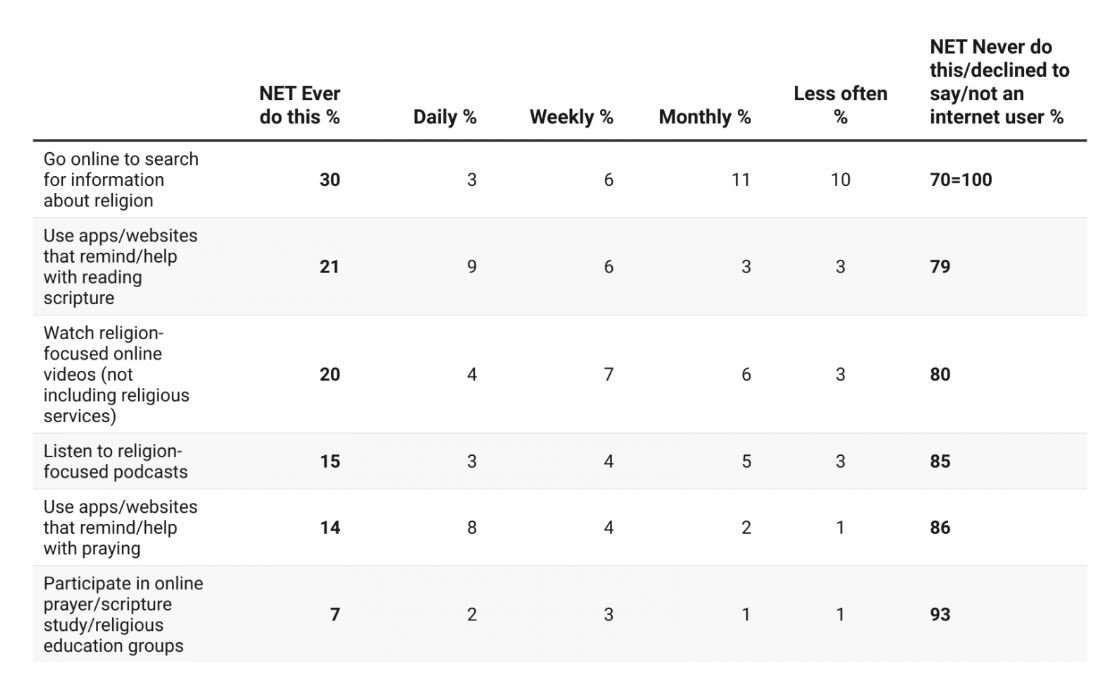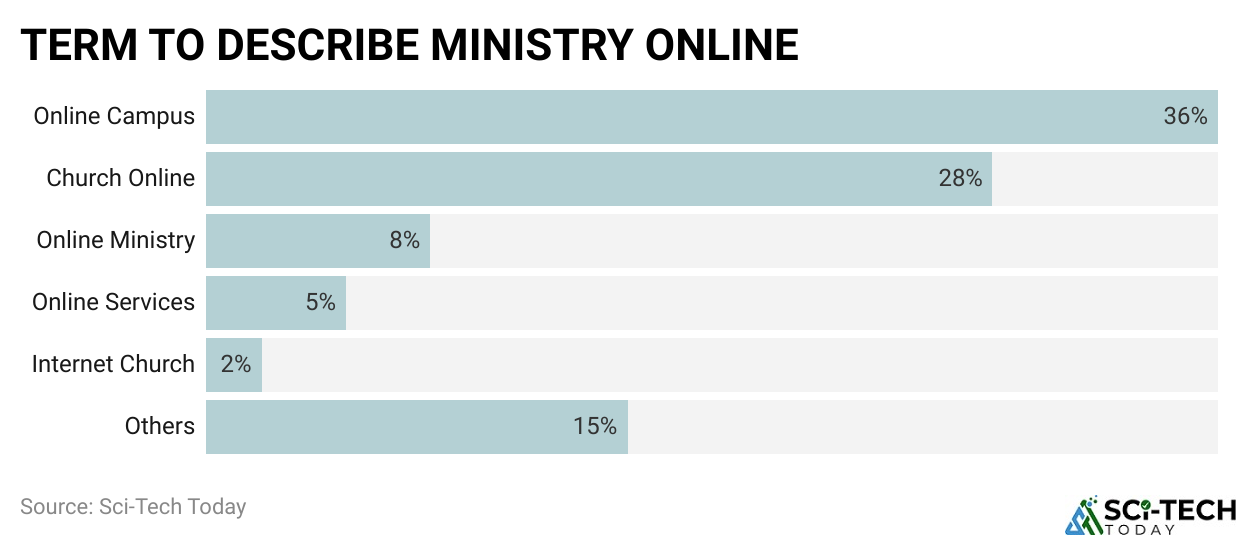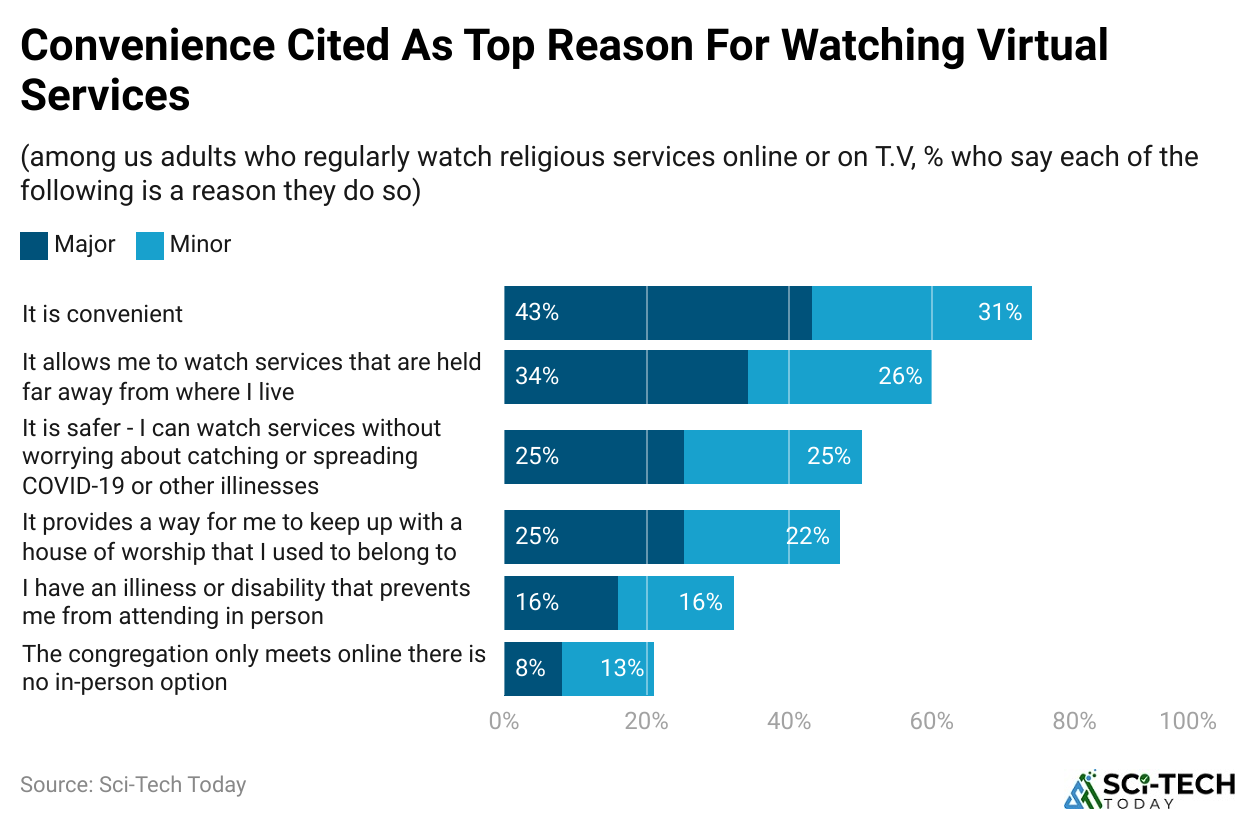Online Church Statistics By Virtual Giving, Live Streaming And Facts (2025)

Updated · Jun 23, 2025


WHAT WE HAVE ON THIS PAGE
- Introduction
- Editor’s Choice
- Online Church Worshippers Statistics
- Online And Virtual Church Attendance
- Online Church Statistics By Virtual Giving
- Online Church Statistics By Virtual Worship Experience
- Online Church Statistics By Reasons
- Online Church Virtual Services
- Online Church By Live Streaming
- Future Projections For Online Churches
- Conclusion
Introduction
Online Church Statistics: The trend of online churches has transformed the very landscape of community connection by faith-based organizations. As always, in 2024, technology continues to bear a critical weight in the lives of millions all over the planet. Increased participation, heftier donations, and a wider reach have characterized modern online churches.
In 2024, online churches experienced over USD 2.2 billion in donations, highlighting a strong shift toward digital giving. Approximately 53 percent of practicing Christians streamed services online, and about 17 million Americans visited church websites without attending in person. Globally, online church attendance is projected to exceed 35 percent by 2025 .
Within the U.S., 27 percent of adults regularly watched services on screens in 2022, including 10 percent who exclusively watched virtually and 17 percent who did both in-person and online. Meanwhile, satisfaction with virtual worship remains high, with 74 percent reporting satisfaction with online sermons and 68 percent rating the overall experience positively. Despite the virtual surge, 76 percent of those engaged both in person and online still prefer attending services in person .
This has made them an important aspect of contemporary worship. This article looks at the most important online church statistics and trends defining the online church landscape as of 2025.
Editor’s Choice
- In 2022, home prayer was preferred by 44% of people, while 53% of practicing Christians attended online church services.
- Online church statistics reveal that approximately 33% of congregants globally discovered their online church services within that year. In America, 17 million churchgoers opted to visit church websites without regular attendance at the service itself.
- By the end of 2022, online church donations had surpassed $2.2 million, with many people tuning in to those services on Sunday mornings while a few still had a preference for in-person visits.
- Among young adults, especially those aged between 18 and 34 years old, African Americans displayed the most significant support for a virtual church service at around 22%.
- Meanwhile, 45% of Americans watched online church services, and 30% went to church services physically.
- Online church statistics indicate that Worldwide, 16% of churches had full-time online pastors, who usually had an average of 2.5 years of experience.
- In the US, 30% of adults participated in online church services to get more information about religion.
- Thus, 21% of online church services have apps and websites to help users read scripture, while 20% of people worldwide watched religion-focused online videos, and 15% listened to religion-focused podcasts.
- Online church statistics show that 14% of people use applications and websites that act as reminders for prayer times, while 7% indulge in online prayer, scripture study, or some form of religious education.
- In terms of global practices, 88% of churches that had an online presence allowed online donations.
- The various categories of donations are defined according to church attendance: mega-churches (those with more than 2,000 attendees) gave $49.99 in an average per-in-person and online donation; emerging mega-churches (1,000–1,999 attendees) averaged $54.90; large churches (500–999 attendees) averaged $52.23; medium churches (250–499 attendees) averaged $52.03; small churches (100–249 attendees) averaged $45.43; and very small churches (99 or fewer attendees) averaged $51.25.
- By the end of 2022, heavy users of religious technology stood at 16%, moderate at 10%, light at 20%, and non-users at 54%.
- Online church statistics indicated that $74.5 billion worth of revenues from online church services were realized in the U.S., with 77% of tithers (those who donated 10% of their income) making up the bulk of the church donations.
Online Church Worshippers Statistics
 (Source: enterpriseappstoday.com)
(Source: enterpriseappstoday.com)
- Online church statistics show that by the end of 2022, slightly fewer worshippers opted for online church services than in-person visits. The largest %ages of online or TV church service worshipers were Black Protestants, with 28% preferring online services and 26% choosing both online and offline options.
- Following white evangelicals (19%), Protestants (18%), Christians (16%), global adults (12%), and non-evangelical Protestants (12%).
- By 2023, the preferences for online church services were most rated by churched adults (20%), Boomers (22%), Millennials (21%), and Gen X (18%).
Online And Virtual Church Attendance
- Virtual church viewers are less likely to feel as connected as those who attend worship in person. For instance, around 65 % of regular in-person attendees will claim to have a strong bond with fellow worshipers as opposed to just 28 % of regular virtual attendees who feel their presence in churches.
- According to online church statistics, 22 % of virtual viewers experience a strong bond with other online participants. Despite the growing number of people who attend church services from a distance, many still do not feel fully engaged.
- For instance, only 25 % of regular virtual viewers would consider themselves active participants in the service.
- About 32 % feel more like passive observers, whereas a further 42 % are somewhere in between. Since the onset of the COVID-19 pandemic, the proportion of U.S. adults participating in religious services has hovered around 40 %.
- Of in-person regular attendees, about 65% will report a strong bond with other worshipers compared to just 28% of the regularly viewing virtual churchgoers, among those who are familiar with in-person attendance.
- Online church statistics indicate that 22% of virtual viewers also feel a strong bond with other participating online people. With a number of those people continuing to attend church on an increasingly remote basis, many of them will still not be really part of the process.
- Thus, it tells you that only about 25% of active, regular virtual viewer participants consider themselves “active participants” in this sort of service.
- About 32 % say they feel much more like passive spectators, with the number of those experiencing a mixed experience at about 42 %.
- Since the beginning of COVID-19, the number of U.S. adults who have participated in religious services has been stable at around 40 %, with a significant decrease in attendance at virtual services as the pandemic declined.
- As of November 2022, 16% of adults in the United States reported attending religious services only in person; on the other hand, 10% would watch services but would not attend them in person. And 17% would participate in both.
- Overall, these ages showed that about 43% of adults within the United States took part in religious services at least once a month, either in physical presence or virtually. Those who engage in both in-person and virtual services overwhelmingly prefer in-person, with 76% of them attending in-person rather than online services.
- Many have cited ‘convenience’ for their continued virtual following of services rather than pandemic-associated reasons.
- Most virtual churchgoers also watch services from non-household congregations; regularly, 10% of U.S. adults watch hosted services from other congregations.
- Some people who attend in-person and online go back and forth between the two, saying they often watch from the church they attend in person.
Online Church Statistics By Virtual Giving
 (Reference: enterpriseappstoday.com)
(Reference: enterpriseappstoday.com)
- Online church statistics show that Virtual church services are seen as the most popular across age groups between 18 and 34, where young African American adults dominate the population by almost 22%.
- On online church donations, 51% of working Catholics donate between two and eleven times annually, while 80% donate weekly to religious organizations.
- Most online giving is done via debit cards: 49% used it; cash – 40%; checks- 7%; and the rest is made up by other means.
- According to the United States, 61% of younger generations say they do not give much to churches. Meanwhile, 80% of Americans donate only 2% of their income through online donations.
Online Church Statistics By Virtual Worship Experience
 (Source: pewresearch.org)
(Source: pewresearch.org)
- Another indicator of the virtual worship experience is whether Americans do the same activities during online services as they would in person.
- The survey then asked regularly attending viewers of religious services how often they do actions such as pray aloud, say responses, sing, or kneel while attending virtual services.
- Online church statistics show that about 39% of regular viewers do such activities at “all times” or “most of the time” during virtual services.
- Members of historically Black Protestant churches are more likely than all Christians, in general, to say they experience these actions continuously when watching services.
Online Church Statistics By Reasons
 (Reference: pewresearch.org)
(Reference: pewresearch.org)
- Online church statistics state that Only 16% of viewers who regularly follow online religious services cite illness or disability as a serious reason for that choice, while 8% think the lack of physical access by their congregation is a serious reason for not attending in-person services. For many, these minor reasons are not sufficient for seeking online worship.
- As a whole, 74% of viewership claims that the number is a combination of strong and slight convenience, while 60% use services that could be watched from farther venues as a reason.
- Nearly half (49%) of the virtual viewers would even consider personal safety to be a reason for wanting to use online service, and 48% would say they do just to still be connected to the congregations they once attended.
- For example, when it is asked about some Americans going to physical services less than before the pandemic, the main reasons that people can give are two.
- One in five U.S. adults says they go to religious services less often, with 21% looking for other ways to engage spiritually and an identical figure saying they still keep away because of concern about COVID.
Online Church Virtual Services
- 27% of U.S. adults admit to participating in virtual religious observances through the Internet or television, according to a Pew Research Center survey.
- Among this figure, 17% of U.S. adults would partake equally in both virtual and physical services, while 14% had no preference.
- Further, among those who go to virtual services, 28% – who attend virtually and 22% – who are just online watchers, reported that online services made them feel closer to their faith and other people.
- Around 39% of those quite regular viewers of such a service indulged in activities such as praying aloud, singing, or kneeling while partaking in the service, while 25% of virtual viewers say they feel like active participants in the service.
- The November 2022 distribution of religious attendance in the United States by religious category found that 43% are Protestant, 24% are Catholic, 19% are Jewish, and 7% are nonreligious, along with 22% who identify as White non-Hispanic, 48% as Black non-Hispanic, and 30% as Hispanic.
Online Church By Live Streaming
- For churches, the best church live-streaming service as of 2022 is “Dacast,” with prices of a starter plan priced at $39/month, an event plan of $63/month, and a scale plan of $188/month.
- Some other streaming services include “Streamingchurch. TV,” which provides a normal unlimited plan for $79 monthly, where a premium unlimited plan goes for $127, and the platinum plan goes for $179.
- For “BoxCast,” prices for the essential plan go to $99/month; the growth plan fetches $149/month, while the experience plan goes for $199/month.
- “ChristianWorldMedia” has a basic plan of 35 dollars monthly and also has pro for 89 dollars.
- “TruthCasting” offers plans at US$39.95 per month, with the additional giving option of Facebook Live and YouTube Live for an additional US$10.
- Online church statistics show that “MyChurchWebsite.com” has tier 1 for $30/month, tier 2 for $60/month, and tier 3 for $100/month. “Vimeo Premium,” a basic plan with a 14-day free trial, with a plus offering at $7/month, $20/month for pro, and $75/month for premium.
- “Muvi” has a standard plan of 399 dollars per month, a professional plan at 1,499 dollars a month, an enterprise plan of 3,900 dollars a month, and an ultimate plan of 8,900 dollars a month.
- There are video-on-demand plans in “SermonCast” that start at $29/month, whereas there is a fee of $49 to access live streaming.
- Finally, “ChurchStreaming.TV” has basic packages at $79/month, standard at $99/month, and premium at $139/month.
Future Projections For Online Churches
- In terms of attendance at online churches, this could potentially rise to over 35% in attendance globally by 2025.
- It is projected that donations through online platforms will reach $3.1 billion in the future, with a growth rate of 10% per year.
- Attendance in virtual reality VR church services is likely to increase by another 8%, attracting a younger, technology-savvy audience.
- In addition, online contributions will still be a significant mode of church funding. With the convenience of digital donations and an increasing trend in apps and websites for contributions, online giving will become the norm for many churches.
- The increased outreach into cyberspace for churches would probably lead to increased participation in global attendance as people connect from different locations with services around the world. The sense of community can be enhanced through virtual small groups, prayer meetings, and other interactive features that help connect virtual congregants.
Conclusion
Through this article on online church statistics, we have found that online churches are now able to embrace the newest and changing audience within the church. These churches, besides wider participation, increased monetary donations, and new ways of using digital tools, are multiplying their height and breadth. Future developments in such trends will ensure that online churches will become crucial areas in the development of global faith communities.
FAQ.
Online church attendance in 2024 opens up to the increase, with some projections saying it could go as high as over 35% globally by 2025. Online church services in most communities, especially younger ones, mostly growing among those miles and miles away from the church congregation, are becoming strong components of many people’s worship habits. Of the population of U.S. adults, for instance, 27% and among young African Americans, 22%, prefer to participate in online services.
It has now become the new and primary means of funding churches. Almost by the end of 2022, that ended up at $2.2 billion in the United States: income through one online platform or another for gifts. This way towards giving online through their predicted increase to reach $3.1 billion by 2025 is set to keep on increasing.
There is considerable popularity for virtual church services, but in many cases, they do not have the same power to foster community as in-person worship. About 65% of regular in-person attendees report a strong sense of belonging with their fellow worshipers, compared to only 28% among virtual attendees.
74% of individuals prefer that option because it makes church services convenient, while 49% opt for virtual worship for personal safety reasons. Other people belong to online congregations since they desire some connection with their faith and the congregation itself, and this counts for 48%.
Virtual church services are expected to gradually multiply in the years ahead to exceed 35% attendance worldwide by 2025. It is projected that online donations will reach $3.1 billion shortly through the increased use of digital platforms and applications to afford or contribute. Future virtual reality church services may greatly attract younger tech-savvy audiences to comprise an even more critical boundary for defining online worship expression.

Joseph D'Souza founded Sci-Tech Today as a personal passion project to share statistics, expert analysis, product reviews, and experiences with tech gadgets. Over time, it evolved into a full-scale tech blog specializing in core science and technology. Founded in 2004 by Joseph D’Souza, Sci-Tech Today has become a leading voice in the realms of science and technology. This platform is dedicated to delivering in-depth, well-researched statistics, facts, charts, and graphs that industry experts rigorously verify. The aim is to illuminate the complexities of technological innovations and scientific discoveries through clear and comprehensive information.









